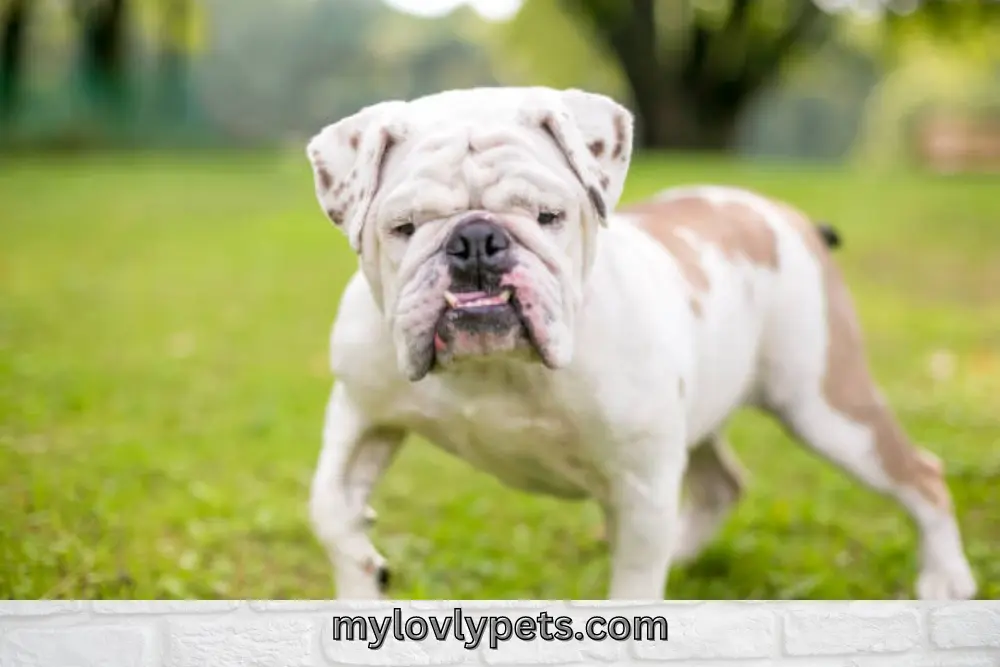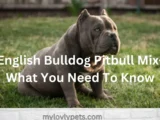
Should English Bulldogs Have An Underbite?
Under bites are a bulldog breed standard, however some stick out while their mouth is closed. Don’t worry unless your bulldog has a problem eating.
Should English bulldogs have an underbite? A brachycephalic dog breed like the English Bulldog may have an underbite because of their short, compressed faces. Their squished face generally leads their lower jaw to be longer than their top jaw, resulting in an underbite. An underbite is common in English Bulldogs, albeit not universally so. Underbites can range from minor to severe.
Is It Normal for English Bulldogs to Have a Underbite?
Yes, your English Bulldog’s underbite is completely normal. The AKC says it is part of the breed standard for English Bulldogs. Bulldogs’ lower jaws are usually bigger, and the lower teeth are usually visible when the dog is resting.
What is Underbite in Dogs

Occlusion refers to how a dog’s teeth fit together. Dogs and humans are different species; thus, our jaws meet differently. Dogs have scissor bites instead of our conventional occlusion, with the top row of teeth mirroring the bottom. As a result, when a dog closes its jaws, the canine teeth and the premolars immediately behind them connect like the blades of a pair of scissors.
Some dogs have a more prominent lower jaw than others, which can cause the lower teeth to protrude even when the dog is relaxed. Underbites in dogs are a common cause of this form of malocclusion.
Aligning a dog’s upper and lower jaws and teeth can be tricky. An underbite malocclusion is considered healthy and normal in dogs if the dog can chew and eat solid food without discomfort. Indeed, the lower dog jaw is usually a little longer than the upper dog jaw, though this is only true for specific breeds, most commonly flat-faced or brachycephalic dogs. Underbite is a skeletal malocclusion that exclusively affects the jaw in a dog.
Should English Bulldogs Have An Underbite?
An underbite is expected in certain breeds and mixes with one of these breeds. The cause is genetic, a structural aberration that has become not just expected but desired.
Canine malocclusion, or underbite, is a dental disorder in which your dog’s teeth are improperly positioned. It is widespread in many dog breeds and can range from moderate, requiring no treatment, to severe, requiring surgery.
Two main reasons for dog underbite:
One reason could be that the dog’s facial structure is standard, apart from the abnormal positioning of its teeth. This problem is called dental underbite or dental malocclusion.
The second reason is that the dog has an abnormal facial anatomy in which its lower jaw is longer than its upper jaw, causing the teeth to misalign. The medical term for this is skeletal underbite or skeletal malocclusion.
Genetics plays a significant role in canine underbites, both dental and skeletal. On the other hand, underbites are bred for in some dog breeds like the English Bulldog.
Do all English Bulldogs Have Underbites?
There are a variety of bulldog breeds, each with its own defining characteristics due to years of selective breeding and alterations to the original bulldog breed.
As a breed, English bulldogs are meant to have undershot jaws, meaning that their lower jaw is longer than their upper jaw. This problem is usually called an underbite.
All English bulldogs do have an underbite. Yet, depending on their pedigree, certain bulldogs may be predisposed to a more severe underbite than others. To project an image of strength and aggression, an underbite is needed for English Bulldogs to meet the breed standard.
Why do English Bulldogs Bred with Underbites?
Underbite is a common problem in English Bulldogs. English Bulldogs have been passing on the condition from generation to generation.
They have short muzzles and flat faces because of their brachycephalic heads. The underbite is easily recognizable because the dog’s lower jaw protrudes and rolls over the top jaw, creating a pronounced underbite.
The undershot jaw characteristic of many English bulldogs evolved due to the breed’s history of participation in bullfighting. Even though it is illegal to use canines in fights against other animals, English bulldogs are produced with underbites since this is a desirable trait according to the breed standard.
What Should an English Bulldog Look Like?

The Original English Bulldog has a large, flat head and a powerful jaw. A pronounced undershot bite characterizes the jaw. Ears that look like roses. The neck is average length, well-muscled, and widens toward the shoulders.
The upper body is bulky, with broad shoulders and thick, sturdy legs. A lot of muscle is displayed, the chest is broad, and the brisket is powerful.
They are slightly sloping from the hips to the shoulders. The hindquarters are higher than the forequarters because they are large, muscular, and longer than the forelegs. Health concerns necessitate docking the tail. This coat is short and sleek.
Since bulldogs have been the subject of extensive modification and selective breeding, several bulldog breeds have developed their own unique traits. The primary objective of the breeder is to temper the dog’s aggressive nature while maintaining its robust appearance.
Does an Underbite Hurt a Dog?
Are underbites anything to be concerned about? Dogs with inherited skeletal malocclusion, such as a mild underbite, pose no health concerns. These conditions typically unaffected normal oral functions, including eating, drinking, and self-grooming. The situation can be tracked and monitored as long as the dog is taken in for frequent examinations.
Yet, dental malocclusion might result in significant health problems. Normal functioning can be hampered when biting mesh difficulties are caused by jagged, oddly developing, or impacted teeth. Dogs with severe underbites often have trouble chewing and tearing food, among other issues. When a dog’s cheek, gums, or roof of its mouth are injured due to a tooth breaking through at an awkward angle, the results can be much more severe.
Should I be Worried about My Dog’s Underbite?
Determining if your English Bulldog’s underbite is painful is the first and most crucial step in addressing the condition.
As was already said, some dogs might have a mild problem that doesn’t cause any problems, while others might have a more serious problem that does. For this reason, it’s essential to keep an eye out for any indications that your dog is experiencing discomfort or difficulty so that you can provide the necessary care.
If your dog has an underbite, no matter how mild or severe, it should not have access to chew toys. In addition, their diet should be modified to include more soft, easily ingested meals.
Should I Fix My Dog’s Underbite?
Take your dog to the veterinary to get an opinion on whether or not the underbite requires medical intervention. Your vet will be able to tell you whether or not your pet needs treatment based on the severity of the issue.
You can use braces to correct an underbite in a young dog. Nonetheless, filling and extraction are viable alternatives. Several types of malocclusions, in addition to the puppy’s age and general condition, determine the available treatment options for an underbite. All of these procedures should be done only at the advice of your veterinarian because of the high cost and risk involved.
Keep an eye on your dog and watch for any signs of pain or discomfort that could indicate a more serious condition, even if your vet doesn’t prescribe treatment.
Will Puppy Grow Out of Underbite?
Unfortunately, there’s no reason to expect your Bulldog puppy’s underbite to correct itself as he gets older. But, if your dog has a significant underbite, your veterinarian may recommend dog braces. As with humans, braces have the best chance of success on a young dog.
Will My Dog’s Underbite Get Worse?
Your Bulldog puppy will likely have an underbite when you get him. But you are wondering whether my dog’s underbite will get worse with age.
Usually, you won’t find your Bulldog puppy’s underbite increasing more severe as he gets older. Generally, it will stay the same way it was when he was little. On the other hand, if your Bulldog puppy has a significant underbite, the consequences could mount up and cause permanent harm.
Should I Buy a Puppy with an Underbite?
There are a few things to think about if you’re looking for a puppy and you happen to come across one with an underbite. Before anything else, think about the future health of your pooch. You should also think about the possibility of incurring larger-than-usual veterinary expenditures in the case that serious issues arise.
While an underbite in a dog may be endearing and even “cute,” prioritizing the well-being of your pet should take first. Yet, it’s important to remember that minor underbites in puppies aren’t always permanent.
Breeds of Dogs Prone to Underbite
Underbites are common in some dog breeds. In general, the lower jaws of Bulldogs and other brachycephalic breeds are longer than the top jaws, leading to an underbite, as we discussed earlier.
It’s considerably more common for specific breeds to have underbites than it is for others. But technically, an underbite can happen to almost any dog.
In breeds where underbite is frequent, it is deemed normal as long as it does not cause any health issues. They include some of the following:
Lhasa Apso
Pug
King Charles Spaniel
Pekingese
The Boston Terrier


